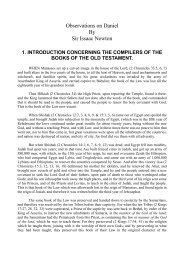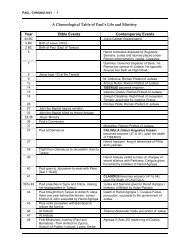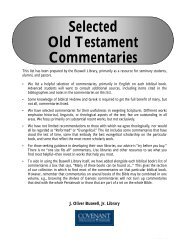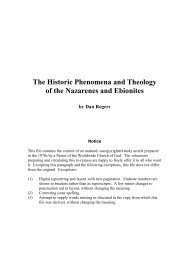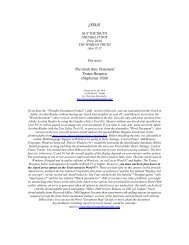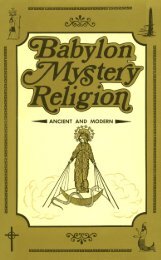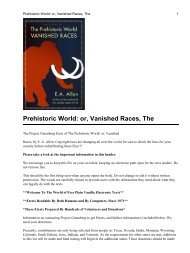Legends of the Shawangunk2 JR.pdf - Friends of the Sabbath ...
Legends of the Shawangunk2 JR.pdf - Friends of the Sabbath ...
Legends of the Shawangunk2 JR.pdf - Friends of the Sabbath ...
You also want an ePaper? Increase the reach of your titles
YUMPU automatically turns print PDFs into web optimized ePapers that Google loves.
38 <strong>Legends</strong> <strong>of</strong> <strong>the</strong> Shawangunk.<br />
meadows and slopes <strong>of</strong> Shawangunk in <strong>the</strong> sunlight <strong>of</strong> that early period, ere man had<br />
been created? Or were <strong>the</strong>y ante-diluvian, and carried to a common grave by <strong>the</strong> deluge<br />
<strong>of</strong> <strong>the</strong> Scriptures? Or were <strong>the</strong>y post-diluvian only, and, until a very recent period,<br />
wandered over <strong>the</strong>se hills and browsed in <strong>the</strong>se valleys?<br />
A formidable objection to <strong>the</strong>se animals having lived within a few hundred years is<br />
<strong>the</strong> difficulty <strong>of</strong> so enormous a creature obtaining sustenance for himself through our<br />
winters. It would seem that <strong>the</strong> mastodon lived in a palæontological period more remote,<br />
when <strong>the</strong> climate was warmer, since <strong>the</strong> allied huge animals do live in warmer latitudes.<br />
Perhaps it was <strong>the</strong> change <strong>of</strong> climate that destroyed <strong>the</strong> mastodon.<br />
Geologists are <strong>of</strong> opinion that <strong>the</strong> mastodon flourished about <strong>the</strong> middle <strong>of</strong> <strong>the</strong><br />
tertiary period. If so, <strong>the</strong>se creatures were here ages before man wad created. The period<br />
<strong>of</strong> <strong>the</strong>ir extinction is thought to be more doubtful, probably just before <strong>the</strong> establishing <strong>of</strong><br />
<strong>the</strong> first human pair in <strong>the</strong> Garden <strong>of</strong> Eden.<br />
The mastodon belongs to <strong>the</strong> graminivorous class <strong>of</strong> quadrupeds. Had he belonged to<br />
<strong>the</strong> carnivorous race, subsisting on flesh, he would have been <strong>the</strong>y most destructive<br />
butcher <strong>of</strong> which we could possibly conceive.<br />
“Otisville, Otisville!” shouts <strong>the</strong> trainman from a set <strong>of</strong> stentorian lungs, opening <strong>the</strong><br />
door <strong>of</strong> <strong>the</strong> Erie Railway passenger coach as <strong>the</strong> train slows up at a little station high up<br />
<strong>the</strong> slope <strong>of</strong> <strong>the</strong> Shawangunk, at <strong>the</strong> eastern portal <strong>of</strong> <strong>the</strong> “Pass <strong>of</strong> <strong>the</strong> Mountains.” We<br />
alighted on <strong>the</strong> platform, and <strong>the</strong> train proceeded on its way through <strong>the</strong> deep cleft in <strong>the</strong><br />
mountain, and <strong>the</strong> rumbling was lost in <strong>the</strong> distance as it crept along <strong>the</strong> dizzy heights <strong>of</strong><br />
<strong>the</strong> western slope.<br />
“Will you please point <strong>the</strong> way to <strong>the</strong> swamp where <strong>the</strong> Mount Hope mastodon was<br />
found?” we said to <strong>the</strong> first man we met, who happened to be <strong>the</strong> village post-master.<br />
“Certainly; come with me. I am going that way and will show you <strong>the</strong> place.”<br />
Following his directions, after a walk <strong>of</strong> about a mile over a rough country road; we<br />
came to <strong>the</strong> place indicated. The swamp has no distinguishing features, and covers a tract<br />
<strong>of</strong> some half-dozen acres. The highway winds to one side <strong>of</strong> it, while a side-hill pasture<br />
borders <strong>the</strong> o<strong>the</strong>r. The mastodon’s remains were found near <strong>the</strong> lower end, only few feet<br />
from solid ground. The creature had evidently ventured into <strong>the</strong> swamp in search <strong>of</strong><br />
food, got mired in <strong>the</strong> peat and marl, and perished <strong>the</strong>re—<strong>the</strong> skeleton being preserved<br />
from decay by <strong>the</strong> antiseptic properties <strong>of</strong> those substances that were instrumental in<br />
causing its death.<br />
There is an excavation sore ten or more yards in diameter where <strong>the</strong> bones were<br />
exhumed, which is now filled with water. The circumstances under which <strong>the</strong> Mount<br />
Hope fossil was found are <strong>the</strong>se:<br />
Some years ago a family by <strong>the</strong> name <strong>of</strong> Mitchel, residing in New York city,<br />
purchased a farm in <strong>the</strong> vicinity <strong>of</strong> Otisville. The land was none <strong>of</strong> <strong>the</strong>



